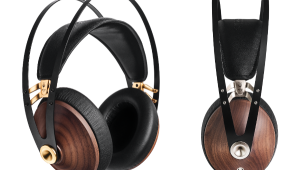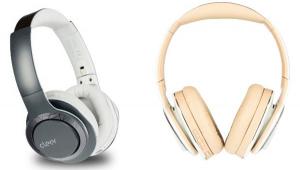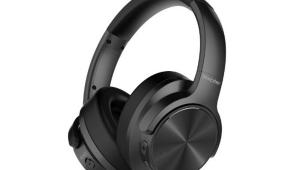Review: Velodyne vFree Bluetooth headphones
With the vPulse in-ear monitor, Velodyne managed a trick most other headphone brands haven’t—it created a big-bass headphone that didn’t sound dull. Now the company has launched two over-ear models: the $399 vTrue, a large, audiophile-oriented model, and the $299 vFree, a relatively compact headphone equipped with Bluetooth wireless. S&V’s Michael Berk reviewed the vTrue, while I’m taking on the vFree.
By far, the most interesting thing about the vFree is the control buttons, which are visually integrated into the right earpiece. The buttons control Bluetooth mating, as well as play/pause and track skip on your connected Bluetooth device (i.e., a smartphone or tablet). They look cool, but they’re not labeled in any way, so you have to remember which one does which. It’s also a little challenging to distinguish them by feel, something that’s not a problem with the typical up/down/left/right control buttons found on many Bluetooth headphones.
Fortunately, the volume up/down and power buttons are separate and it’s possible, although not particularly easy, to find them by feel.
A micro USB charging input assures you’ll never have a problem finding a charger. If the charge does run out, though, there’s a standard 3.5mm input for a cabled connection, and a cable is included. It’s available in black or white. The included carrying case is just a flimsy little bag—kind of a disappointment for a $299 headphone.
Hands and ears on
Our usual West Coast panelists, voice actress Lauren Dragan and jazz musician Will Huff, thought the integration of the vFree’s controls into the right earpiece was really cool. That is, until they tried to use them. All three of us often found ourselves inadvertently mashing the wrong button—for example, skipping to the next track when we wanted to pause. I guess you’d get used to them … I guess.
Will complained that he had trouble finding the volume controls. He also likened the design to “a lollypop … it’s more the kind of thing that would appeal to teens.”
Lauren, possessed of the smallest head and ears among the panelists, found it difficult to get a good seal around her ears, because the earpads are so small; in fact, you could make the case that the vFree is really an on-ear, instead of over-ear, design. But Will and I had no problem getting a good seal, and we both found the design quite comfortable for long-term use.
Bass in the place?
We wondered if the vFree would keep the big-bass tonal balance of the vPulse. Well, it does, but only when the cable’s connected. When I played Led Zeppelin’s “Dancing Days” with the vFree’s cable connected to my iPod touch, the tonal balance was even bassier than the vPulse’s. As with the vPulse, the mids and highs sounded clean and uncolored, but the bass was just too much for me.
“OK, now I can hear the headphone,” I thought when I mated the vFree to my iPod touch through Bluetooth. The bass still sounded strong, but in a much more realistic balance with the rest of the audio spectrum. The mids were especially nice; Robert Plant’s vocal and Jimmy Page’s guitar both sounded clear, clean, and super-detailed. Even the muffled, buried background vocal sounds in “Dancing Days”—which sound almost like a mixing error—were easy to make out. I heard a little bit of emphasis in the upper mids and lower treble, about maybe 2.5 or 3 kHz, but that characteristic helped bring out the vocals in a way that added a touch of excitement and realism.
While the bass balance sounded just right, the bass itself seemed a little soft to me. On “Dancing Days” and then “D’yer Mak’r,” the next tune on Houses of the Holy, John Paul Jones’s electric bass sounded somewhat muddy, as if he were plucking with his thumb up around the base of the instrument’s neck rather than with his fingers or a pick (I’m not sure which) nearer the bridge.
The somewhat soft, fat bass sound worked perfectly on ZZ Top’s “Chartreuse,” though, perfectly portraying bassist Dusty Hill’s old-school Texas groove. I couldn’t find a thing to complain about with the vFree’s sound on this tune. The next cut on La Futura, “Consumption,” sounded even better, the tune’s huge, deep bass pumping hard and fast. Just for fun, I switched back to the cable, but here the vFree passed its limits, distorting badly in the bass. With this headphone, the cable’s definitely a last resort—but that’s often the case with self-powered (i.e., Bluetooth and noise-cancelling) headphones.
While the vFree sounded pretty great to me with rock and pop, the bass was too big for my favorite jazz tunes. Even with the Bluetooth connection, the bass in vocalist Sue Matthews “I Fall In Love Too Easily” sounded about +6 dB too loud. It was like hearing a live gig with a bad soundman. Or like Matthews’ regular bass player got sick and the only other bassist she could find was Dusty Hill.
Will thought all the music he played via Bluetooth from his iPhone through the vFree—from Nirvana to Mos Def to Samantha James to Steely Dan—sounded great. “It’s very refined and well-balanced,” he said. “I found it extremely easy and enjoyable to listen to. I’d liken it to driving a Bentley.” He did find himself pining for a little more volume, though.
Lauren liked the sound, too, although not as much as Will and I did. She found the bass, even in Bluetooth mode, a little soft, although she did comment that it retained a decent sense of pitch. For her, though, the midrange definition and the sense of depth and space were a little lacking, flaws she suspected were related to her problems getting a good fit.
- Log in or register to post comments




































































